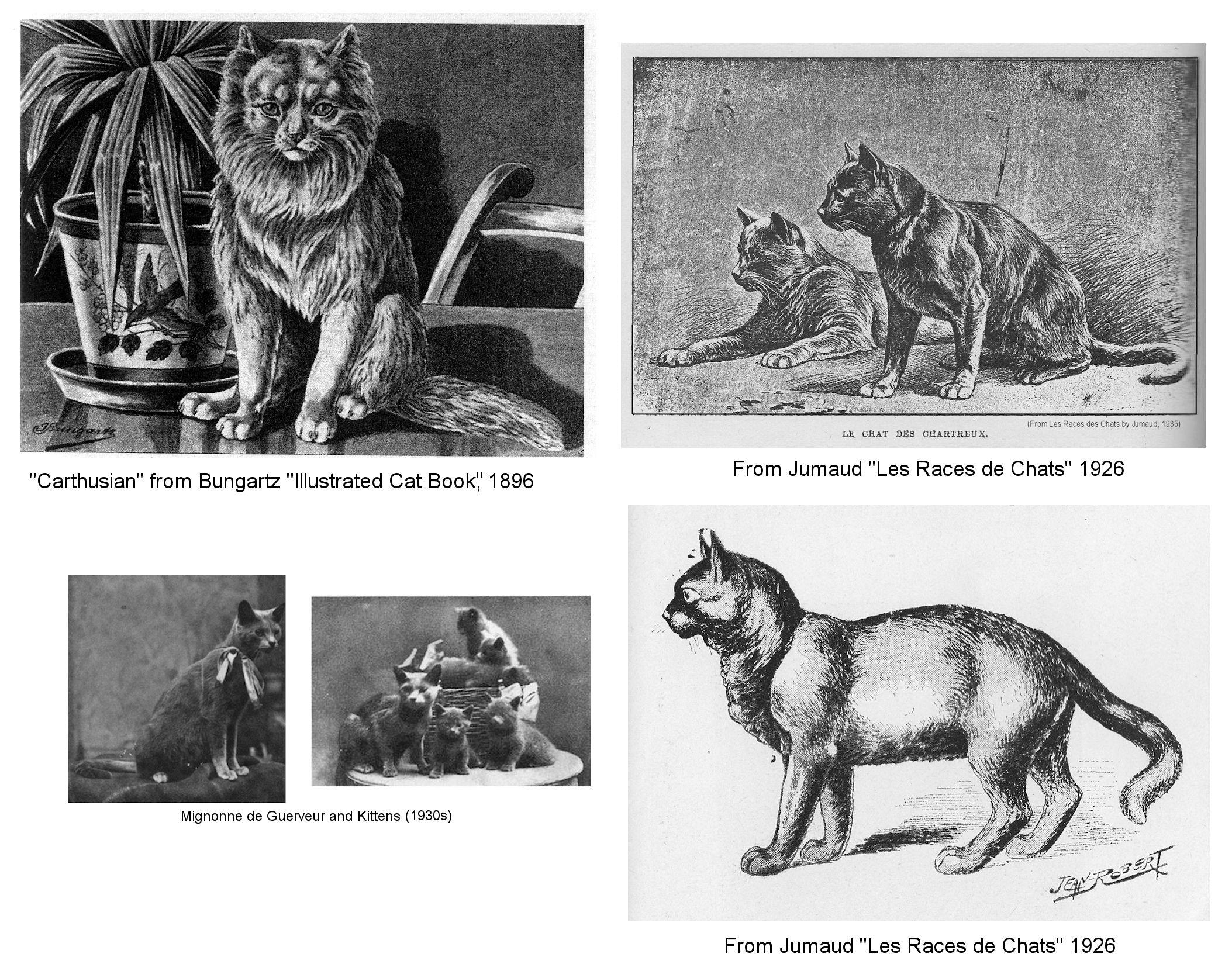
THE CHARTREUX CAT – AN EARLY HISTORY
The purebred Chartreux (or Chartreuse) exists only in the colour blue, ranging from ash-grey to a deep-slate blue. The tips of the fur give the coat a silvery sheen. While it is one of the oldest natural breeds, it was not recognized as a breed by British fanciers at the dawn of the organized cat fancy. In fact all blue cats were at one time lumped into a single “Blue Shorthair” category, regardless of whether they came from Britain, Russia or Thailand, and they were judged against the ideal for the British Shorthair.
According to (Harrison Weir (Our Cats and All About Them, 1889), the “Blue Cat” (Blue Shorthair) was often shown under a number of names “It was at first shown as the Archangel cat, then Russian blue, Spanish blue, Chartreuse blue, and, lastly, and I know not why, the American blue. It is not, in my belief, a distinct breed, but merely a light-coloured form of the black cat.“ He set out a standard for shorthaired blue cats at British shows: rich bluish-lilac with dark nose and pads dark and orange-yellow eyes. “If it is a foreign variety, I can only say that I see no distinction in form, temper, or habit.” The only other blue shorthair he admitted to was that from Archangel which had larger ears and eyes, longer heads and legs and very short fur that was “rather inclined to woolliness, but bright and glossy.”

While the Russian Blues eventually got breed recognition in their own right, and the “blue Siamese” were eventually recognized as Korats (and another blue/faint blue-tabby breed, “Canon Girdlestone’s” or “Norwegian” vanished entirely), the Chartreux was not recognized by the British cat fancy until very recently. When I wrote to ask about this in the early 1990s, I was told it was classed as a British Blue Shorthair, even though it did not meet the standard for that breed. There have been centuries of rivalry – sometimes enmity - between Britain and France, and I am tempted to think that national pride influenced the refusal to recognize the Chartreux, a case of “why have a French blue cat when we have a homegrown British blue cat?” and this remained the status quo until other registries, such as FIFe and TICA, became more active in Britain. In the 1950s, French cat-fancier With similar national pride, Fernand Mery wrote in the 1950s that the Chartreux was not to be confused with the British Blue, calling it a cat of rural France.
According to Phyllis Lauder, writing in "The British, European and American Shorthair Cat" (1981): "In France the Blue shorthairs are known as Chartreux. There has, now and then, been put forward the idea that the British Blues and the Chartreux were different varieties of shorthair cats; but well-known judges in France and Britain have always been aware that the two terms are simply different names for the same cats. The Blue shorthair doubtless existed in France and England in the Middle Ages; it is quite reasonable, indeed, to suppose that he voyaged as ship's cat from Calais to Dover and back and if the fancy took him, went ashore and settled in either country."
According to the modern wording of the standard, which is based on the 18th Century texts, it is medium-sized, with orange or copper-orange eyes, upright ears and a relatively narrow muzzle on a broad head and thick powerful neck. The shape of its head and muzzle give it a sweet “smiling” expression. Its body is robust and set on fine boned legs - meaning less cobby than the British Shorthair - and compact feet. This led to the rather unfair epithet of “a potato on toothpicks" Some breed standards (CFA, TICA) call for the legs to have relatively fine boning compared to body mass, while other breed standards (FIFe, LOOF) require sturdy legs with medium to large feet, and leg boning less massive than the British Short/Longhair or Persian. Its blue fur is dense, medium-short with a resilient undercoat, and becomes slightly woolly with age. The fur often parts like sheepskin at the neck and flanks. It is a very slow-maturing breed and the coat reaching its full glory after three years of age. Indeed it was once prized for its fur which could be dyed and sold as Otter.
CHARTREUX ORIGINS
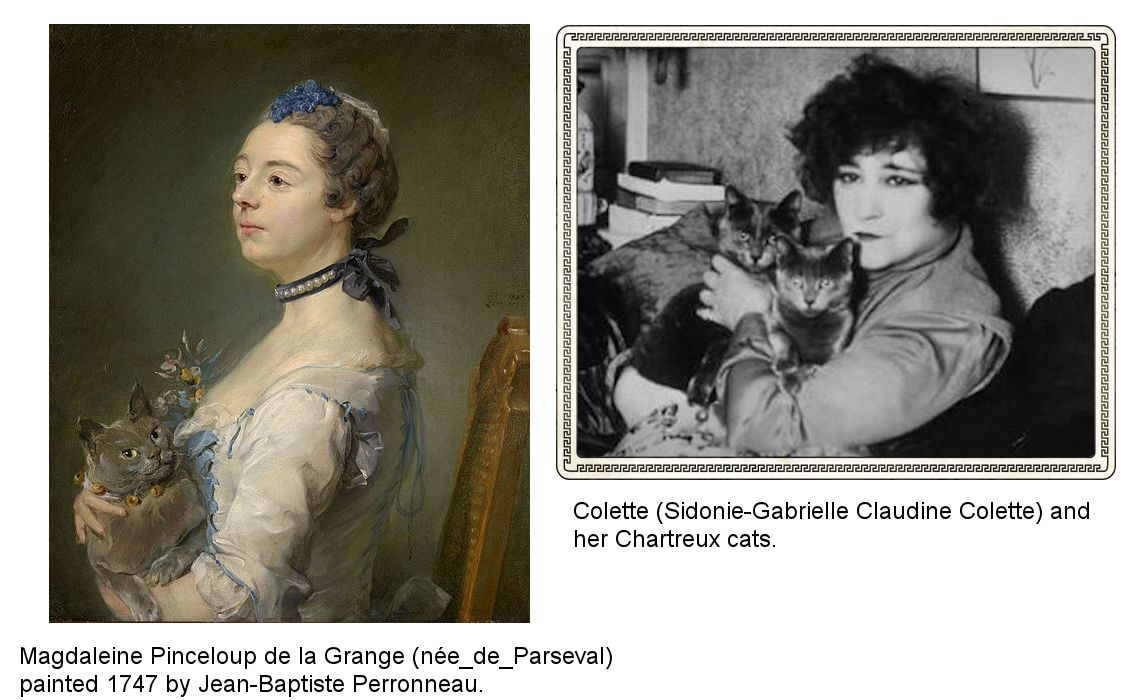
The grey cat of France is mentioned for the first time in 1558 by Joachim du Bellay in a poem entitled “Vers Français Sur La Mort D'un Petit Chat” (French Verse On The Death Of A Little Cat). Du Bellay compares the grey of his own cat (a bicolour) to the silvery grey of the French cats.
C'est Belaud mon petit chat gris, [. . .]
Ne fut pas gris entièrement
Ni tel qu'en France on les voit naître,
Mais tel quà Rome on les voit être
Couvert de poil gris argentin,
Ras et poli comme satin . . .
(It is Belaud my little grey cat [. . .]
Was not entirely grey,
Not as they are seen in France,
But as they are seen in Rome
Covered with silvery-grey hair.
Short and polished like satin . . .)
He again mentions the grey cats in his “Sonnet to Menine”:
Ménine aux yeux dores, au poil doux, gris et fin,
La charmante Ménine, unique en son espèce.
Ménine, les amours d’une illustre Duchesse
(Menin with golden eyes, soft hair, grey and fine,
The charming Menin, unique among her kind.
Menin, the loves of an illustrious Duchess
In “De Quadrupedibus Digitatis Viviparis Libri Tres” (1637), edited by Bartolommeo Ambrosini, the Italian scientist Ulisse Aldrovandi describes cats in Chapter X. Although few domestic cat varieties are described (compared to domestic dogs) there are a number of engravings which, in later editions are coloured based on the author’s description. One coloured illustration – Cat on a Ledge With Fruit - shows a grey cat with orange eyes and slightly striped tail. In a previous edition, this is an engraving of a ticked tabby cat which Aldrovandi called a “Syrian cat” (Felis Syriaca). Aldrovandi never visited France, and in common with writers of his time would have based his writings on travellers’ reports. The later illustrator changed the speckled tabby into a grey cat. In John Ray’s “Synopsis methodica animalium quadrupedum et serpentine generis” (1693), the Syrian cat is called the “Cyprus cat” which other authors describe as tabbies.
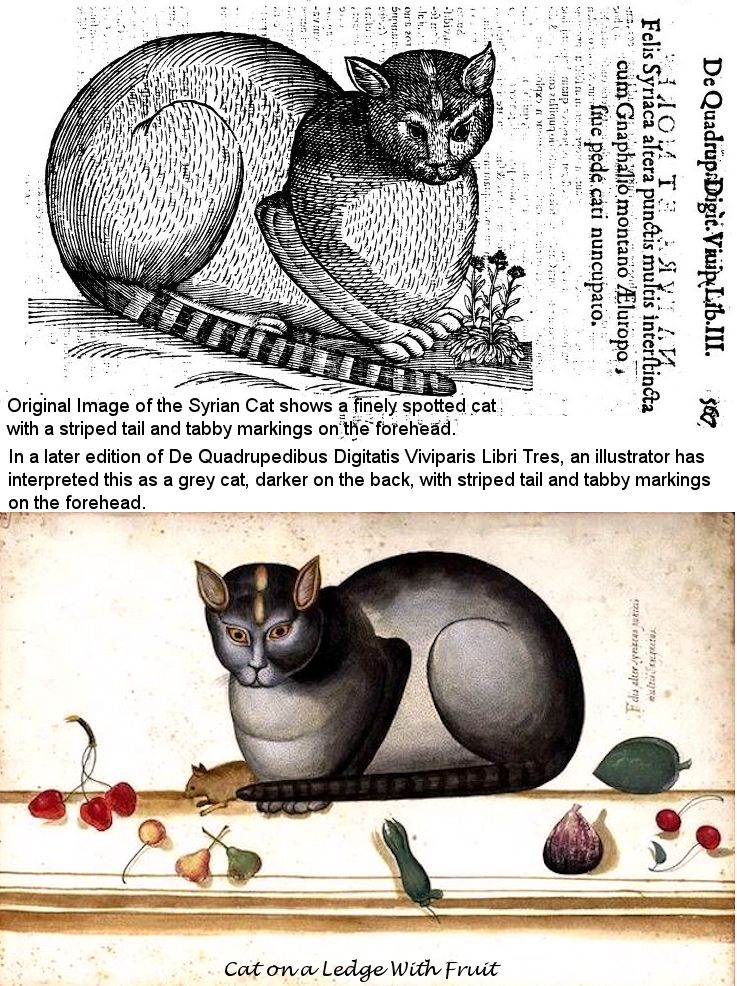
In 1727, Moncrif’s “Histoire de Chats” mentioned the beautiful grey cats from Malta. The references to Syria, Cyprus, Malta, Italy and France correspond to historical commercial routes, such as the great Silk Road, between the Middle East and parts of Europe and Asia. Syrian cats may well have travelled on trading ships, but cats from the Middle East are unlikely to have had thick double coats, and in the context of colour, “Maltese” actually refers to a grey-blue dye (or fabric) rather than a geographical place of origin.
There is a representation of a Chartreux in 1747 in Jean-Baptiste Perronneau's painting “Magdaleine Pinceloup de la Grange” where, unusually for that period in France, the cat is shown in the painting as a pet (unusual because the cat more often represented rampant sexuality in France at that time).
The origins of the Chartreux, or Carthusian, are shrouded in legend. It is commonly said that that the Chartreux traces its origins to cats taken from South Africa by Carthusian monks to live in the Carthusian order's head monastery, the Grande Chartreuse, north of Grenoble, in the Chartreuse Mountains in France. In the monastery they may have protected the grain stores and the ingredients used in Chartreuse liqueur. Though this is a charming story, in 1972, the Prior of the Grande Chartreuse denied that the monastery's archives held any records that the monks kept cats resembling the Chartreux.
Another legend claims that the ancestors of the Chartreux were feral mountain cats from Syria, taken to France by returning Crusaders in the 13th century. Many of the Crusaders later entered the Carthusian monastic order, supposedly taking their cats with them as companions.
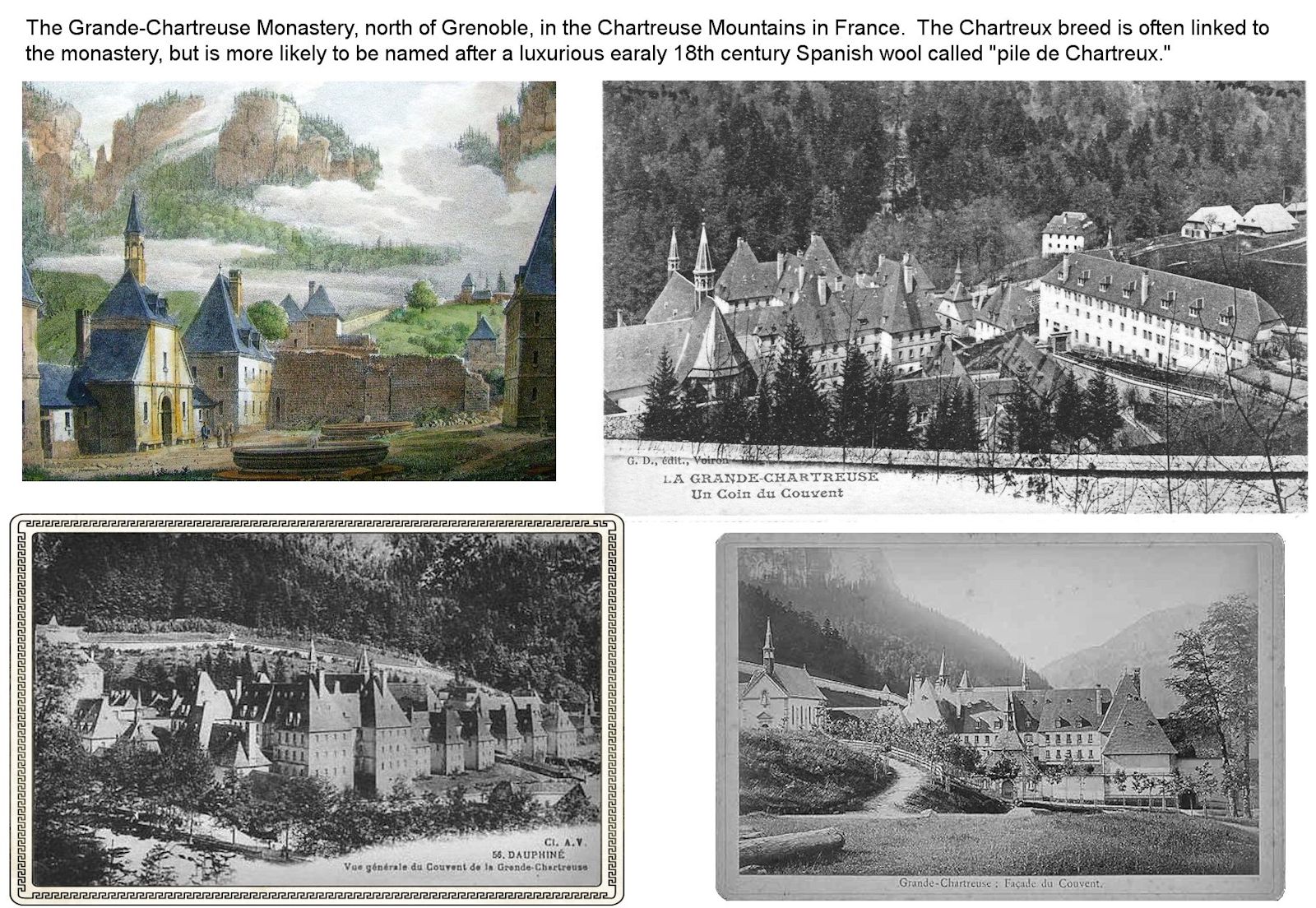
In 16th Century literature, it was known simply as the "little grey cat" of France. A more prosaic, and probably more accurate, derivation of is modern name comes from the similarity between their woolly coat and a luxurious Spanish wool called "pile de Chartreux" of the early 18th century. The Chartreux cat had developed a dense coat from generations of surviving outdoors in often harsh conditions. In the 18th century, the dense-coated Chartreux was prized by furriers as it could be dyed and sold as Otter. It is mentioned in a number of dictionaries of commerce as being valued for its fur.
According to Page 812 of “Dictionnaire universel de commerce, d'histoire naturelle et des arts et métiers” (Universal Dictionary of Commerce, Natural History and the Arts and Trades) of Jacques Savary des Bruslons (1723): "CHARTREUX, Le vulgaire nomme ainsi une sorte de chat qui a le poil tirant sur le bleu. C'est une des espèces de fourrures dont les Pelletiers font négoce." [The common name of a cat with fur leaning towards blue. It is one of the furbearing species traded by furriers.]This is the first known use of the name Chartreux for this cat.
In Encyclopédie, ou Dictionnaire raisonné des sciences, des arts et des métiers (Encyclopaedia, or Dictionary of Science, Arts and Crafts), by Denis Diderot et Jean le Rond d’Alembert, in 1753, we find "Chartreux, (Hist. nat.) sorte de chat dont le poil est d’un gris cendré tirant sur le bleu. C’est une des peaux dont les Pelletiers font négoce, amd qu’ils employent dans les fourrures.” [A sort of cat with cinder-grey fur leaning towards blue. It is one of the skins traded by furriers and used in their fur garments.”]
In his “Histoire naturelle de Buffon,” 1754, Georges Louis Leclerc comte de Buffon mentions the Chartreux in comparison to the Persian, Angora and Spanish cats. “Pietro della Valle parle d’une espece de chats qui se trouve en Perse, dans la province du Chorazan. On voit par la description qu’il en donne, que ces chats de Perse resemblant par la couleur a ceux que nous appelons chats chartreux, et qu’a la couleur pres ils resemblant parfaitement a a ceux que nous appelons chats d’Angora.” [Pietro della Valle speaks of a species of cat found in Persia, in the province of Chorazan. You can see from his description that these Persian cats resemble, in colour, those we know as Chartreux cats, and whose colour perfectly resembles those we call Angora cats.]
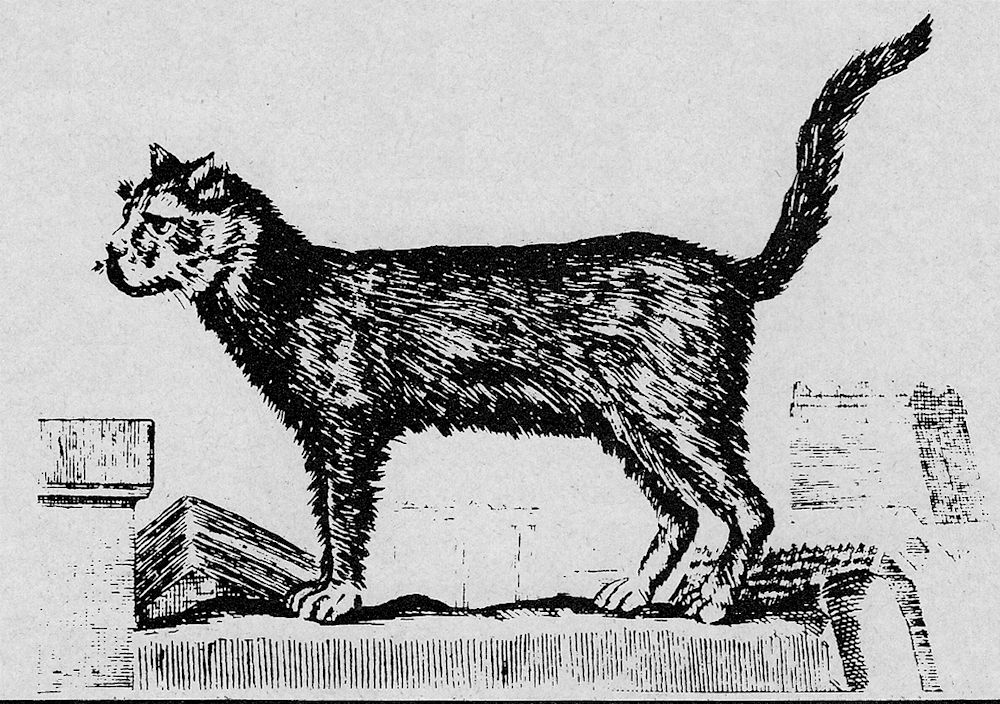
(Histoire Naturelle Vol 4: The Natural history of The Cat (Georges Louis Leclerc, Comte de Buffon (1767)): "In Persia, says Pietro della Valle [Voyage, tom. 5. p98] , there is a species of cats which properly belong to the province of Chorazan. Their figure and size are the same with those of the common cat. Their beauty consists in the colour of their hair, which is grey, and uniformly the same over the whole body, excepting that it is darker on the back and head, and clearer on the breast and belly, where it approaches to whiteness. . . . . From this description it appears, that the Persian cats resemble, in colour, those we call Chartreux cats, and that, excepting in colour, they have a perfect resemblance to the cat of Angora. It is probable, therefore, that the cat of Chorazan in Persia, the cat of Angora in Syria, and the Chartreux cat, constitute but one race. . . The wild cat, like most other animals in a savage state, has coarse colours, and hard hair. But, when rendered domestic, the hair softens, the colours vary; and, in the favourable climates of Chorazan and Syria, the hair grows long, fine, and bushy; all the colours become more delicate; the black and red change into a shining brown, and the greyish brown is converted into an ash-coloured grey. By comparing the wild cat with the Chartreux cat, it will be found, that they differ only in this degradation in the shades of colour. “)
In Dictionnaire raisonné et universel des animaux ou le règne animal (Universal Dictionary of the Animal Kingdom), by François-Alexandre Aubert de La Chesnaye des Bois, 1759, the Chartreux is described under Domestic cats. “Pour sa couleur i lest ordinnairement gris et noir, gris et blanc, ou noir et blanc. On estime les Chats d’Espagne, a cause de leurs belles et differentes couleurs. On nomme a Paris Chat Chartreux, ceux qui font entirement de couleur cindree.” [As regards colour, it is ordinarily grey and black, grey and white, or black and white. People value the Spanish Cats for their beautiful and varied colours. In Paris there is a cat named Chartreux which is entirely ash-coloured.]
In Dictionnaire raisonné universel d'histoire naturelle : contenant l'histoire des animaux, des végétaux et des minéraux, et celle des corps célestes, des météores, and des autres principaux phénomenes de la nature; avec l'histoire et la description des drogues simples tirées des trois regnes ... plus, une table concordante des noms latins (Universal dictionary of natural history, containing the history of animals, vegetables, and minerals, celestial bodies, meteors, and other principal phenomena of nature; With the history and description of simple drugs drawn from the three kingdoms ... with a table of Latin names) 1775], Jacques Christophe Valmont de Bomare repeats Buffon’s description.
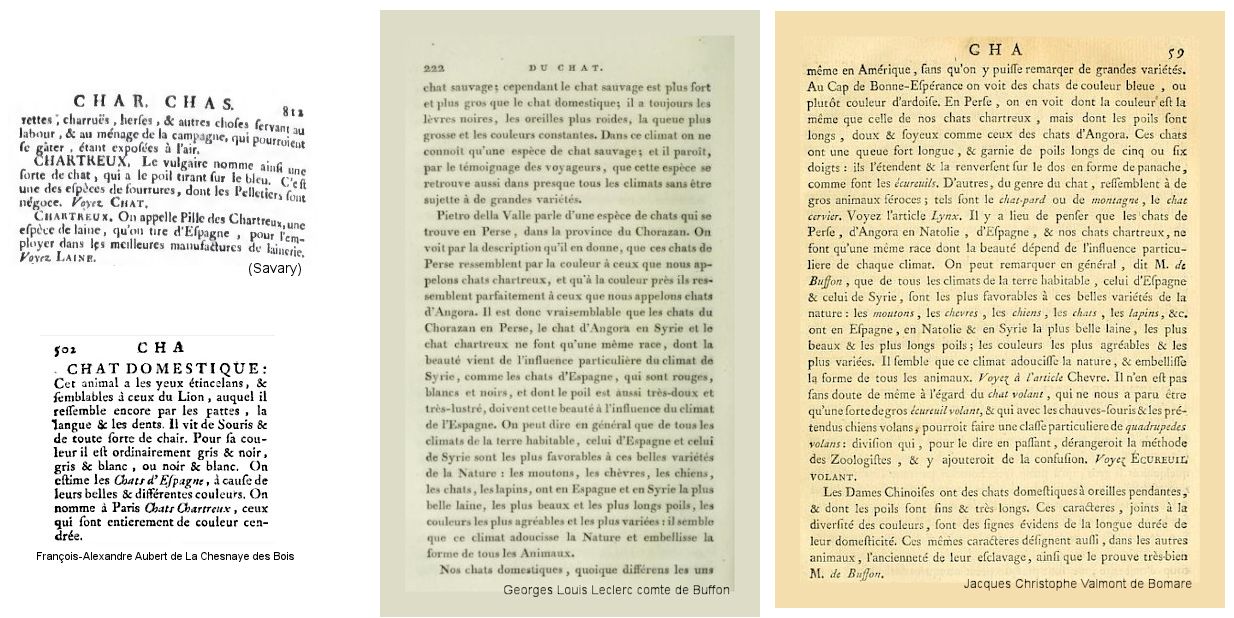
According to Simonnet’s book “Étude sur le chat des Chartreux” (1972) , during the 18th and 19th centuries, the pelt of the Chartreux was used in making fur garments and would have been bred for that purpose in order to supply good quality pelts to the furriers. According to Houttyn in his translation of Linnaeus “One still encounters daily in France people who eat these well-fed and fat cats called Chartreux; they eat them roasted or cut up in stews.”
Recent DNA research suggested that the origin of the modern Chartreux was in ancient Persia, but this is more likely to be due to outcrossing to Persians and British Shorthair by Paris Cat Club members after the First World War, particularly the use of a Persian stud, Japouk du Fouilloux, in the 1930s.
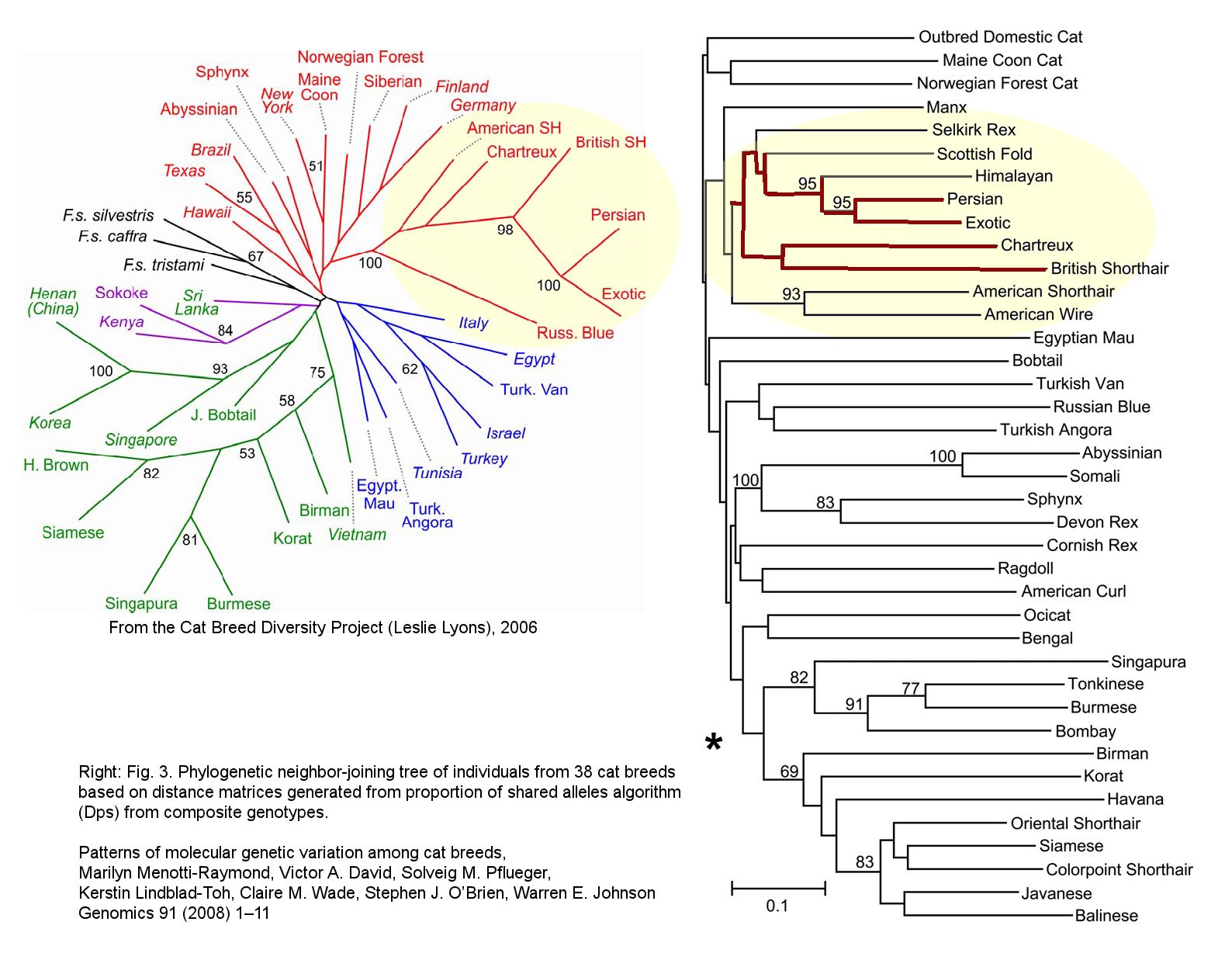
19TH CENTURY CHARTREUX
Some of the early descriptions describe the Chartreux as having longer fur, what we’d term “semi-longhair”. In the 18th century, naturalist Buffon considered the breed familiar enough that he described a Blue Persian by likening its colour to that of the Chartreux. He believed the Persian, Angora and Chartreux to be related. Buffon wrote that a comparison of the Wild Cat with the Chartreux cat found they differed only in the greyish brown colour of the wild cat being changed to ash-coloured grey in the Chartreux. German writer Jean Bungartz described Carthusian, the Chartreux's other name, in "An Illustrated Cat Book" (1896) as a self-coloured blue variety with long fine hair, black lips and soles and being somewhat phlegmatic, like the Angora, the Persian. The Chartreux even had its own Latin name under the Linnaean system: Felis catus coeruleus, meaning "blue cat."
According to Gaston Percheron (The Cat, Its Natural History, Health and Illnesses, 1885): "Chartreux, or Cat of the Carthusians. This cat is quite large. It is distinguished by its coat which is long, cottony and uniformly gray with bluish reflections. It is a beautiful animal, but somewhat inclined to laziness. It is believed to be a native of Syria."
Alexandre Landrin (Member of the French National Society of Acclimatisation and of numerous Academies and Societies of Savants in France, Spain and Italy) wrote in “The Cat. Zoology – Origins –History – Behaviour – Habits – Races – Anatomy – Illnesses –Jurisprudence” (1894): “Chartreux Cat. Felis Catus coeruleus. The Chartreux cat is a pretty gray slate colour; it has very fine hair, a little long, but woolly. The lips and soles of the feet are black. It is a lively and alert race which, after the Tiger Cat, comes closest to the Wild Cat.”
The image below, from Bungartz's "Katzenrassen" 1897, shows the Chartreux as having a plumy tail and the rest of the coat looks like a semi-longhair. The illustrator was probably working from descriptions rather than from life.
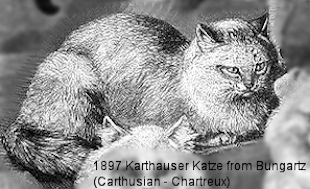
According to Helen Winslow in “Concerning Cats” (1900), The blue cat was ordinarily known in the USA as the Maltese and there was a tradition that it came from the Island of Malta, and many people didn’t consider it a distinct breed, merely a light-coloured version of the black cat. Winslow reeled off the usual array of alternative names for blue cats - Archangel, Russian blue, Spanish blue, Chartreuse blue, and Maltese – and likened the soft fur to sealskin. Frances Simpson, in the more famous “Book of the Cat” (1903) did not mention the Chartreux and her view on blue shorthairs was to have a single “self blues” class judged on the same lines as British short-hairs to create a uniform type.
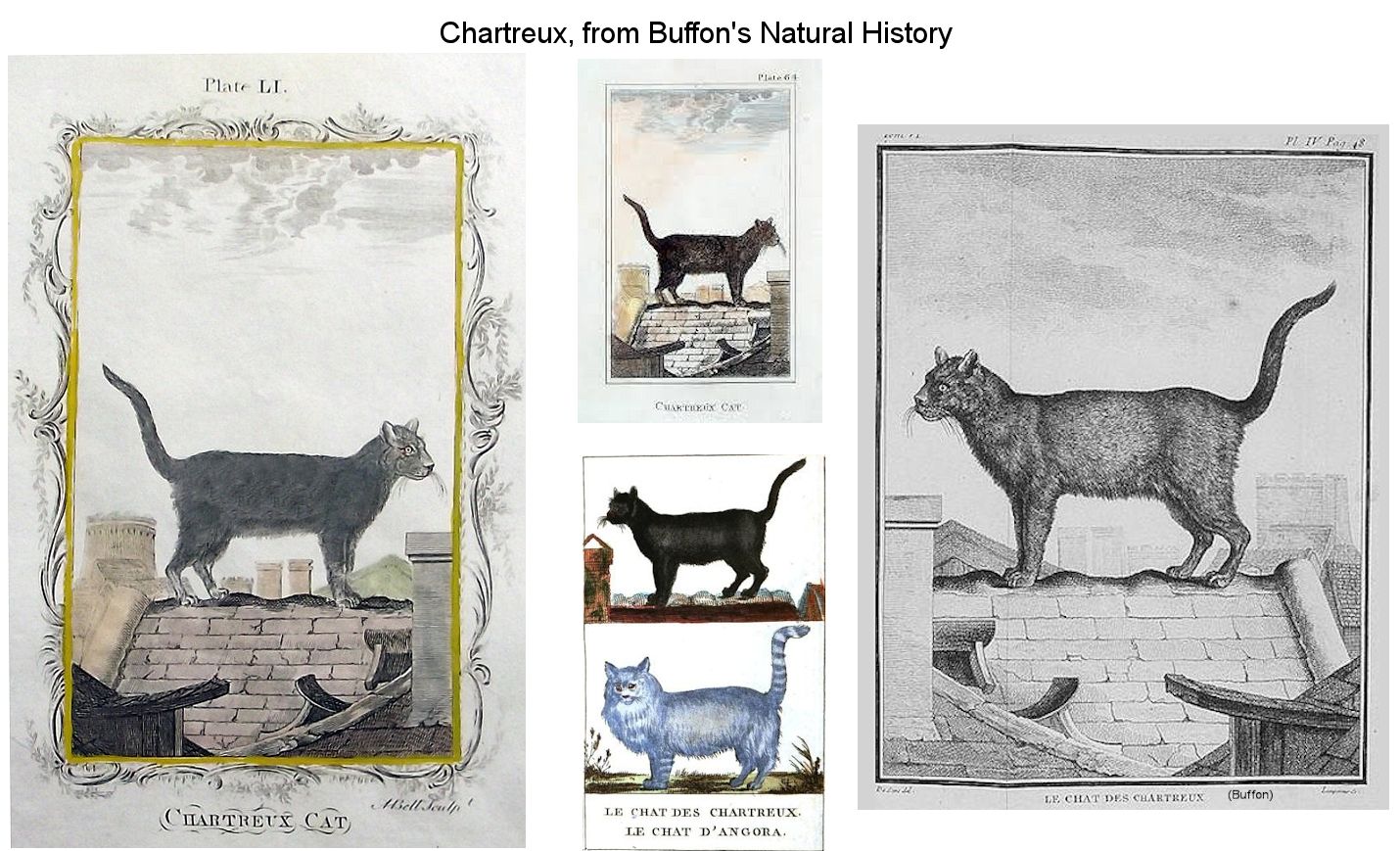
The organisers of the early Paris cat shows seem to have considered Chartreux to be blue semi-longhairs, similar to the late 19th century authors in their comparisons of the Chartreux and Angora. "Le Chenil : journal des chasseurs et des éleveurs" (The Kennel – The Magazine for Hunters and Breeders) contained accounts of early French cat shows, because the early shows were organized by "Le Chenil.” In the announcement for the Paris show of 1901 (before the show), there was a category for "Chat des Chartreux." One paragraph relates to the Angora, Persian and Chartreux. According to the show management, the monks created the long haired "Chartreux" breed by combining Persians with ordinary blue cats. There’s no evidence of any Chartreux being entered in this show. In 1902, two cats originally entered as Angoras were transferred by the show management to the class for "Chartreux" because they were blue. These were the only "Chartreux" at the show. Early French cat clubs began organising shows between 1912 and the beginning of WWI. There might have been some short haired blue cats at these early French cat shows, but they were not listed as "Chartreux." Following WWI, the cats exhibited as "Chartreux" seem to have been shorthaired blue cats.
CHARTREUX AFTER THE FIRST WORLD WAR
Note: There are old show reports from mainland Europe, some of which mention the Chartreux, at Early Cat Show in Europe
According to “CATS IN ITALY” By George de Southoff, C.M.Z.S. (writing in Cat Gossip in 1927), “There is a great deal of confusion in the terminology of cat races: for instance, what I call Carthusian is the L.H. Alpine strain with short nose and small rounded ears, which may have originated at the Carthusian Monastery, near Grenoble (La Grande Chartreuse). Carthusian cats are spread over the Alps of France and Switzerland; I have already told you of the cats of this race I found at Viege. Carthusian cats are not, normally, found under 700 metres above sea level. I think they have nothing in common with L.H. Russian cats, which last are of Eastern origin — Persia, Turkestan — and may he derived from the Manul cat.
Historically famous Chartreux owners include the French novelist Colette (Sidonie-Gabrielle Claudine Colette, 1873-1954) who made her Chartreux “Saha” the heroine of her books "La Chatte" and "Les Vrilles de la vigne." Colette bought "Saha" (also known as "La Chatte") from a breeder at a Paris cat show in the 1920s; a date that corresponds to the Leger sisters' breeding. Colette's earlier book, "Dialogues de bêtes" featured a "Chartreux cat" as one of the main characters. Charles Baudelaire supposedly owned a French grey cat. French president Charles de Gaulle, whose cat’s name was “Gris-Gris”(pedigree name "Ringo de Balmalon.")
The early breeders and exhibitors, after World War 1, had based their breed standard on 18th Century naturalist descriptions and Chartreux from those breeding programmes were exhibited in France in 1928. It was listed as a breed in the newly founded Federation Feline Francaise (FFF) Paris. Natural colonies of these blue-grey cats existed in parts of France up until the early twentieth century. The modern Chartreux trace their ancestry to a few individuals from small, isolated colonies of domestic cats in France collected by breeders interested in preserving this ancient breed. One such colony lived in the grounds of a hospital located on Belle Ile sur Mer (“Beautiful Island on Sea”) off the coast of Brittany, where they were known as the hospital cats”. The Leger sisters, living on the island, began to selectively breed the cats. These hospital cats were probably one of the last breeding colonies of Chartreux, and they became the foundation of the modern Chartreux breed. They started their breeding programme 1925 or 1926, breeding the "hospital cats" together under the "de Guerveur affix." For over 25 years tcontinued breeding the cats without outcrossing to other bloodlines or breeds. They bred their cats under the “de Gueveur” prefix. In 1931 their Chartreux "Mignonne de Guerveur" was judged to be the most beautiful cat in the Paris show, and in 1933 she became International Champion and Best cat in a cat show organized by the Cat Club de Paris. In 1935 the first standard for the Chartreux was published in “Vie a la Campagne.”.
Wolf von Metzsch-Schilbach (Breeder of the Federation for Cat Breeding and Cat Protection e. B., Dresden) wrote in his “The Book Of Cats; Breeds And Breeding, Behaviour And Characteristics” (1926): “CARTHUSIAN CAT. It is true that Brehm says: "We know just as little about the origin of these particularly hairy cats, as we do about other silky-haired domestic animals, to which we also like to add the 'Angora' for previously unclear reasons. In any case, this uncertainty alone must not give us cause to accept that the Angora cat can claim a special descent, for example, from the Manul. But Brehm briefly and succinctly describes the Chartreux cat’s coat with two lines. We leave it to Bungartz to describe it as follows: “a self-coloured blue variety with long fine hair (Brehm says: long, soft, almost woolly), black lips and black soles to its feet. The blue colour varies from bluish ash-grey to bluish-black.” The attached figure showed a cat hardly distinguishable from the Persian cat. The assumption cannot be far off that this the same thing but given a different name, just as Persian cats are also known as Khorassan cats.”
In 1926, Dr Jumaud's book "Les Races des Chats" (Breeds of Cats) likened the Carthusian, or Chartreuse, cat ("Felis catus carthusianorum") to the "Maltese cat" known in the USA. It had a large head with large, full eyes, short nose and small, erect ears. Its coat was "half long and woolly" and the colour was grey with bluish reflections.. Jumaud's book was based largely on the works of Professor Cornevin of Lyons.
In 1927, judge Mrs Basnett reported on the Paris Cat Show held on 14th and 15th of January by the Cat Club de France and wrote, " Looking through my catalogue I saw a class marked 'Chats de Chartreux,' which did not appear to be a breed known in England, so I went round to find out what they were and was told 'The American cat' - and concluded that nobody was quite sure as another owner said they were Maltese."
Around the 1930s, Doctor and Mrs. A. Loir were interested in the selection of feline ratters. They published a book entitled "The Cat - its usefulness” published in 1930. The photo of the cover is the head of a Chartreux cat with this comment “This is Minet, the very beautiful blue ratter of Madame Brindeau Sigaudy,” and on page 77 the authors state "Among the species reputed to be hunters is mentioned the Chartreux cat".
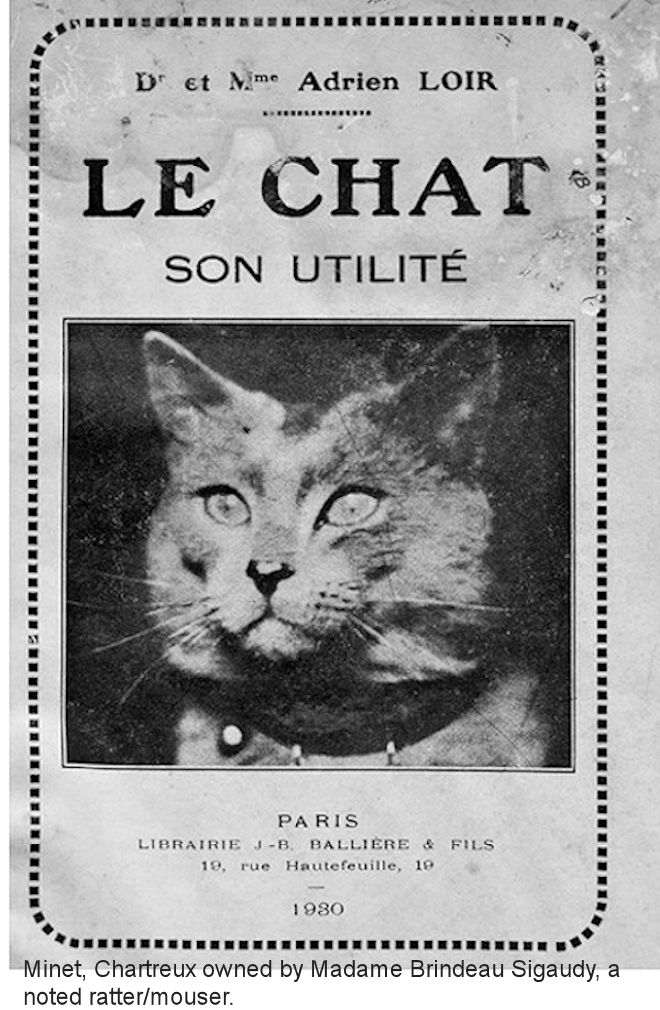
The Leger sisters wrote in 1935 “In the country, we also found these cats and the strange thing they were all of the same type, despite breeding with the European cats of the land, they had kept their characteristics. We acquired several of those cats, and from the first generation we obtained remarkable results. From the very first breeding of a blue male cat and a female blue cat, we had a litter of kittens all blue and perfectly typed.”
Around the same time, a group of breeders in the Massif Central area of France, affiliated with the Paris Cat Club, began breeding Chartreux using native blue cats from the countryside crossed to a blue Persian male, Japouk du Fouilloux, whose parents had both been imported from England. This deepened the eye colour and created a more massive type of cat, improving the native breed (1930s Persians were less extreme than modern Persians, though Japouk was considered extreme by the standards of that time). These breeders added native blue cats, but they also used Persians, Russian Blues, British Blue Shorthairs, and a Siamese. They linebred to Japouk du Fouilloux resulting in a Chartreux that incorporated physical aspects of the 1930s blue Persian.
Jean Simonnet bought his first Chartreux, Guilleri d’Andeloya, in 1958. Having shown Guilleri at the Hotel Continental in 1958 and won the title of International Champion, he became more active in the breed and also wrote a short piece about the Leger sisters. They were two of five children whose mother had died in the Spanish flu epidemic of 1918. In 1926, their father moved the family to Le Palais on Belle-Ile. Christine and Suzanne Leger had graduated from the National School of Horticulture at Versailles in 1925, so were very well educated. On the 30 hectare farm on Belle-Ile the family raised Setter dogs. The immediately noticed the numerous blue-grey “hospital cats” eking out a living on leftovers. The sisters were familiar with Buffon’s works and saw that the cats corresponded to his description of the Chartreux.
M. Durodie was the first breeder to buy a Chartreux from the Leger sisters with "Chat Comme Ca," but then other breeders including Simmonet obtained cats from them, adding to the gene pool. The sisters were strong-willed and not easy to get along with, and there seems to have been a falling out with the Paris Cat Club in the 1930s, after which the cat club left them to their own devices until the 1950s.
THE 1930s AND THE LEGER SISTERS' BREED STANDARD
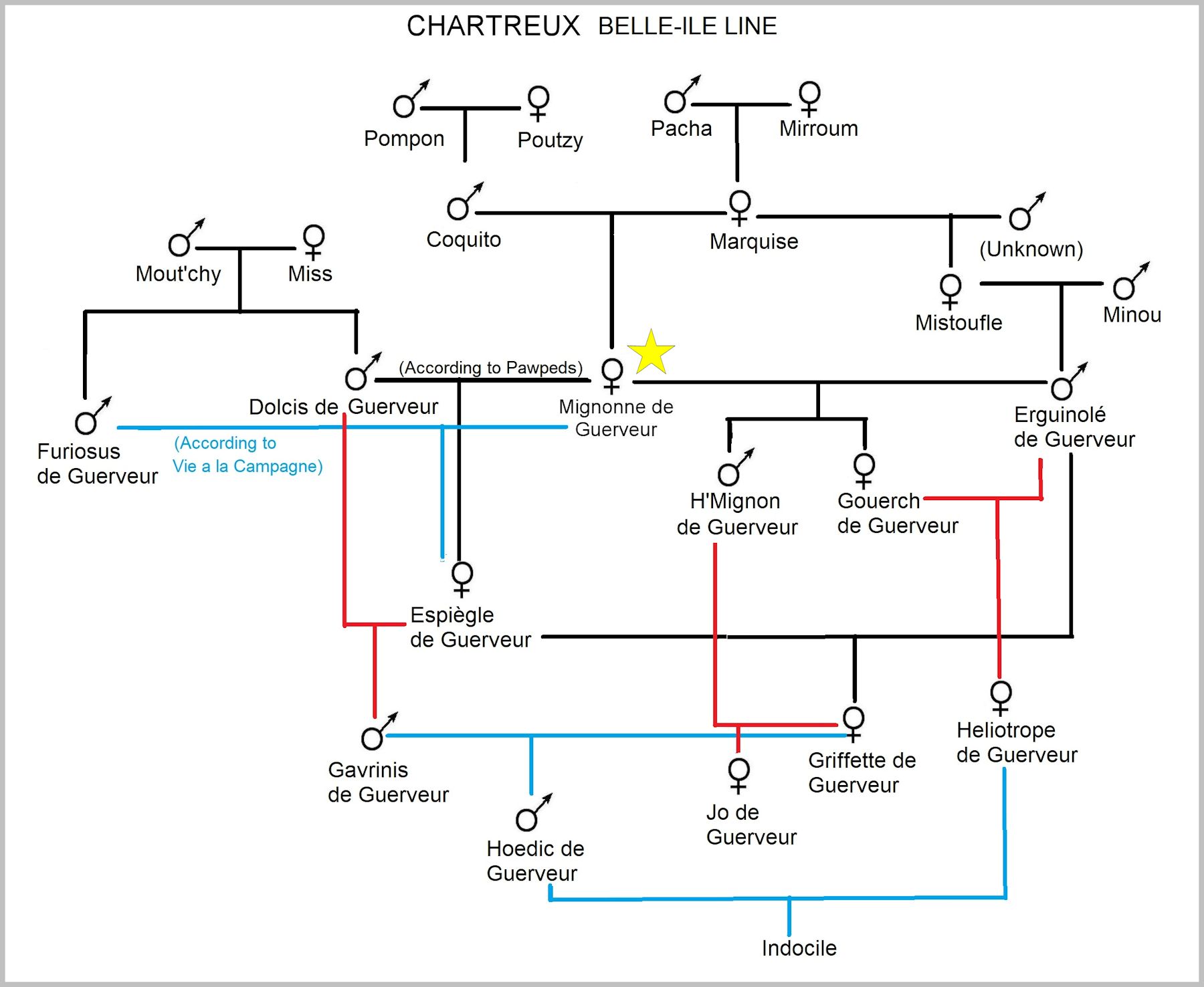
THE CHARTREUX CAT – A RECONSTITUTED BREED
(Vie a la Campagne, 15 April 1935, Volume 92)
An ancient breed, of ancient origin and well-defined type, of which several specimens were found in Belle-Ile-en-Mer, which we selectively bred.
THE CHARTREUX CAT, often equated with the British Blue or Russian Blue Cat remains little known. This breed seemed to disappear completely a few years ago, and it was by happy coincidence that we were able to find some specimens and undertake breeding. Currently, we know no-one except ourselves in France, who are breeding these. However, we must mention the efforts of Mr. and Mrs. Trafford, who have a beautiful couple, and whose male, Hector de Guerveur, is on his way to becoming a champion.
ORIGINS. The origin of the Chartreux Cat remains very poorly known. After breeding this variety for ten years, we wanted to know its origin; unfortunately, our efforts to recover the strain and standard of these cats have only been relatively successful. What is certain is that this is a very distinct variety and cannot be equated with any other. Indeed, the name of the Chartreux was not made up, it is not a vague appellation, but is the name of this race.
We have found in a 1756 edition of Buffon’s Natural History (vol 6, page 12) a description of this Cat, which he calls "Cat of Chartreux" and for which he even gives an engraving (PL IV). Unfortunately, Buffon speaks only of its colour (ash grey) and not of its eyes or conformation. However, observing that engraving, it is easy to see that this is a cat with very long back, quite leggy, with a long tapered tail, though it's hard to judge the head.
Rene Primeverre Lesson, in the 1827 edition of his Manual of Mammalogy, describesf the genera Felis Catus according to Linnaeus and quotes four varieties: the domestic Cat, the Spanish Cat, the Angora Cat, and finally the Chartreux Cat ( Felis caeruleus [blue cat]). In the great Encyclopedia of Trouessard, page 877, we still find mention of the Chartreux Cat. Trouessard calls it the Chartreux Cat (Felis domesticus caeruleus) and believed it to be a hybrid of the Egyptian Cat and the Manul (Felis manul). This is a long way from the Russian Blue and British Blue.
It is therefore reasonable to believe that the Chartreux name has an authentic origin, which, unfortunately, we have been unable to find, and it is probable that, in a Carthusian monastery, the Fathers selectively bred this variety and gave it their name in the same way that the Saint Bernard Dog was selectively raised by the monks of Mont Saint-Bernard.
RECONSTITUTION OF THE BREED
Our first specimens had a French origin; they were found in France, and we imported nothing from abroad. During the first year of our installation at Belle-Ile, we were struck by the number and beauty of some short-haired blue Cats, which were called, at the Palais, "the hospital cats" (meaning a hospital held by a religious order). In the countryside, we also found these cats and, remarkably, they all had the same type and, despite crosses with the European shorthaired cats of the countryside, they kept the characters of their type. We have acquired many of these Cats (I can say that, currently we have collected all the beautiful specimens of the island) and, from that first generation, we obtained remarkable results, From the first crossing of a female blue with a male blue, we had a litter of kittens all blue and true to type. It seems, then, that there was a good chance, in our opinion obviously, of reconstructing a breed that, through the years and through crossing with others, has kept its essential characteristics.
The first female blue cat acquired at the Palais, “Marquise,” was carefully mated to a blue tomcat from the hospital, “Coquito,” and we got the famous “Mignonne” who became international champion, holder of the Belgian Challenge Cup and of the Prize for Beauty at Paris 1933 (Cat Club of Paris) given to the most beautiful cat in the whole exhibition. She was decreed by Miss Wade, who judged at Paris in 1931 to be "the most beautiful Chartreux cat in the World". Mignonne has been the foundation of our breeding, and it is allowable, in view of this success, to base the conformation of this breed on her. But Mignonen is neither a British Blue nor a Blue-Russian. The British Blue is a massive cat, with gold eyes; the Russian Blue is a slender Cat with green eyes. Mignonne is a slender cat, with gold eyes.
A MODEL OF PERFECTION
General Appearance: Extremely elegant, with an innate grace (which has earned a prize for aesthetics), it is not very big, in fact rather small. The male is stronger, more powerful, and taller; nevertheless, he must not have a frame that is too powerful and even when he is fully mature he must retain style and elegance.
Head: Very reminiscent of the Siamese by its elongated shape and absence of jowls. Silver-grey nose, more or less dark in accordance with the coat colour, but not pink or depigmented.
Lips: Very dark blue, almost black, likewise the palate.
Eyes: Pale gold in Mignonne, but we later obtained copper eyes in some of her children (Gouerch) and grandchildren (Hoedic), and that is the sought after colour. Often there are green highlights in the eye, but through selection, we have manage to eliminate this.
Ears: Large and upright, giving the cat an alert look.
Skull: fairly flat and somewhat narrow, very reminiscent of the Siamese by its shape.
Jaws: quite strong, well put together.
Cheeks: Straight and without jowls, especially in the female.
Nose: Fairly long, but not excessively so, with, preferably, a small break at the rise so that the muzzle is distinct.
Neckline: Long; this adds to the cat’s lines and gives it a handsome and attentive carriage when it raises its head.
Body: the shoulder is long, well defined, with a beautiful curvature; it is well muscled; the forearm continues in a manner pleasing to the eye and is also long and thin.
Paw: round, small, exquisitely delicate; the dark grey sole is almost black.
Chest: deep, down to the elbow, and wide.
Back: long, well muscled, extremely flexible.
Belly and flank: The belly is undeveloped and must be that of the quintessential predator. The flank drops slightly and must not weigh down the line of the body as a whole.
Hind-quarters: The rump should be lower, but must continue the line of the back.
Thighs: Very muscular, long, and like the shoulders should must have a curve pleasing to the eye.
Tail: One of the main characteristics of this Cat, very long, tapered, high and cheerful.
Coat: This varies in hue from silver-grey to slate-blue. Mignon and Hector are very light, with a silvery tone becoming lighter on the paws and muzzle; an ideal coat. Unfortunately, it seems that, this light coat goes hand in hand with a pale gold eye; in fact, Gouerch and Hoedie, who have copper eyes, have a slate-grey coat. It is no longer the flattering outfit of Mignonne and her son, but the beauty of the eyes increases. White hairs or markings in the coat are disqualification faults. Often these cats appear somewhat striped with darker blue when they are young; but these shadow markings must disappear complete with age.
Fur: the texture of the fur must be woolly, and, when stroking the Cat against the grain, you must have the impression of touching velvet; in other words, the fur should be short, woolly and close-lying.
Skin: On brushing back the hair, the skin appears uniformly blue, without any white or pink spots.
Weight and size: Females weigh 2.5 kg to 3 kg, males weigh 3 to 4 kg. Naturally, castrated cats can exceed this weight, the size is that of the Siamese.
Overall appearance: Supple, very feline.
Faults: White hairs, coat colour other than blue-grey; tabby markings in adults, heavy structure, exaggerated size and weight, heavy and massive head, jowls, green eyes.
Disqualify: White markings.
SCALE OF POINTS:
General structure, 20; eye colour, 20; Head: ears, 5; nose or muzzle, 5; cheeks, 5; general form, 5; Hair texture, 10; Coat colour, 20; Tail, 10. Total, 100.
QUALITIES AND SKILLS
The Chartreux Cat is above all an instinctive hunter. This is his goal and if the hunting contests were possible, I would not be afraid to put my subjects in competition with the famous feline ratters of Le Havre. It is for precisely this reason that this breed is very interesting as it combines with beauty to give a superior cat. The reason this breed was created is therefore fulfilled, and we are not dealing with one of those lazy cousins who lounge around both night and day. When I let my old Dolcis out on pleasant nights, every morning he brings to my doorstep one of those enormous coastal rats, as big as a 6-month-old kitten, which infests the countryside. He also hunts the supposedly elusive grey rat in our attic. Espiegle, at the age of four months, in front of a nest of mice which he had discovered under the maize, he caught two mice in his mouth in the twinkling of an eye, and one in each paw. The young Fft-fft, at two months old, caught a field mouse and I had to fight and hit him so he would not eat it. A feast for the eyes, the peace of a home rid of rodents, that is the Chartreux Cat.
Independent in character, he does not like being held; he accepts caresses from his masters, but is wary of strangers; very cuddly and affectionate with people he knows, he is less so with his own kind, and there are often disputes in his own family! I've seen, among other things, Mignonne slapping one of her daughters who was teasing her, and that was much the funniest thing I've ever seen.BREEDING METHOD
The Chartreux Cat is very rustic [hardy]; though like his friend, the European Cat, the horrible typhus extracts a high price from him. He is more resistant to this than the Persian Cat, and infinitely more resistant than the Siamese Cat. At Belle-Ile, we have a very harsh climate because of the humidity and the wind, and I had to give up raising Siamese cats because the all died of coryza. My Persians resist conditions fairly well, and my Chartreux are "at home". Although I have installed Catteries, I let my Chartreux roam free whenever I can, except for females that are in oestrus and wandering tomcats are always are always locked up.
For food, in the countryside I give them almost exclusively meat; in the city, I moderate the consumption of meat. When possible, I always prevent them from eating any prey they have hunted, because I have noticed real cases of poisoning by rats and moles; moreover, when well fed, they hunt for pleasure and almost always bring back their prey. The females are quite prolific, but it is exceptional if they have more than one litter a year; at least I don’t seek this because it would be tiring for them. Three or four kittens are born, though I have had a cat that always gave me 8 kittens, which is not desirable because the little ones are born weak and grow poorly. Whenever possible in favourable weather the kittens are raised in freedom and brought in only at night or in bad weather. This way I obtain very vigorous specimens.
These Cats require little care; their coat is always clean in the country; simple brushing is enough before exhibition. There is currently no Chartreux Cat Club; the creation of such a club would be worth considering and would certainly be of interest, because their fans increase daily.

MAIN CHAMPIONS
Many of the cats we have bred have won championship status, and these are the only champions I know in France. International Champion: Mignonne de Guerveur who won 38 prizes including 20 firsts, 6 C. A.Cs, 32 special prizes of honour. Her daughter, international champion Gouerch de Guerveur of the Central Feline Society, Cat Fanciers Club; holder of 37 first prizes, 4 C. A Cs, 6 special prizes, etc., and who, at his last show, in Paris, in January 1935, won the honorary prize awarded to the most handsome shorthair Champion; also Mignonne’s son Hector de Guerveur, on his way to becoming champion won - also in Paris, in January 1935 – the Challenge Cup for the most beautiful shorthaired cat in the whole exhibition; a great-grandson of Mignonne, the handsome Hoedic de Guerveur, holder of 15 first prizes, 4 C.A.Cs, P. S. and P. H. currently also international champion.
In 1933, our breed won the honorary award of the President of the Republic, awarded to the most beautiful brerd of shorthaired cat.
FUTURE OF THE BREED.
This breed is still little known (witness the extravagant reactions of show visitors), and it is to be hoped that our societies quickly popularize the breed and show that it has its own characteristics, its interesting points and usefulness.
C. LEGER
F. Schwangart (Dreden) commented on the Chartreux at the Paris Cat Club show in his scientific book “On Racial Constitution And Breeding Of The Housecat (Results And Problems)” (1932) wrote: “Some cat books at home and abroad combine the appearance of North American blue cats with a supposedly special hair quality, slightly longer than our Sshorthair, and sometimes "short-haired with frill", so that one thinks of half-angoras. We find these called "Carthusian" or "Maltese" (after "Maltese dilution"). The splendid collection of Blue Shorthairs at the Paris cat show this year (1931) were cautiously titled "said to be Chartreux" in the catalogue. They did not include any American specimens. What could be seen were a variety of shapes of pure Blue Shorthairs. It is, therefore, quite possible that the name Carthusian is in reality not assigned. It would be useful to breeders who want to select for the Persian type in Blue Shorthairs (like Fig. 13 and 14) (see Footnote).
[Footnote: Among the few cases of completely Persian-type heads on Blue Shorthairs which I have seen, there was recently a verifiable crossing with a Longhair. Caution should be exercised when assessing such animals.]”
For some reason, the Cat Club breeders did not follow Suzanne Leger's 1935 standard and adopted a different breed standard that Simonnet referred to as the 1939 standard. This later standard was much simpler and placed more emphasis on the Chartreux being a large, massive cat. Later breed standards were based on a modified version of this later standard. Over a long period of time, the Persian influence in the Cat Club lines was gradually reduced. The cats became slightly taller and more elegant, with straighter profiles, longer muzzles and bigger ears. It’s not fully clear when the 1939 standard came into being. Up until 1948, Suzanne Leger’s standard was still appearing in books. The later standard appeared in a book published in 1955. At first the Paris Cat Club bloodlines were distinct from those maintained by the Leger sisters on Belle Ile, but beginning in the 1950s, the two groups began to exchange cats, and the bloodlines began to merge.
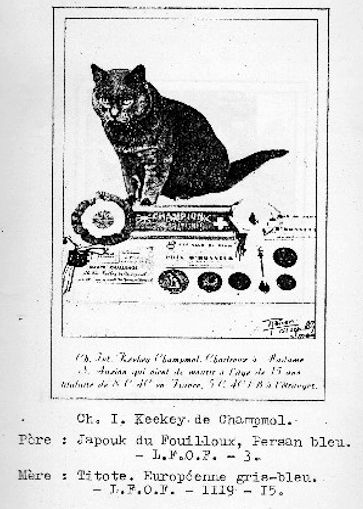
CHARTREUX AFTER THE SECOND WORLD WAR
In common with cat breeds across Europe, the Chartreux breed came close to extinction during the Second World War. During the Second World War most of the cats had died and only Keekey de Champmol survived. He was mated to a natural Chartreux called Trisette and they formed the basis of the renewed breeding programme. There were no known natural colonies of the original robust blue cats left in France, though feral cats of Chartreux type were added to the breeding programme (some might even have been the descendants of Chartreux that had strayed during the war). New blood was introduced using British Blue and Blue-Cream Shorthairs, some of which had Persian or Russian blue in their ancestry. Some Chartreux breeders exchanged cats with British Shorthair breeders in England, who needed outcrosses to widen their breed's gene pool. Some Chartreux can also be seen in British Shorthair pedigrees, confusingly registered as BRI because the British cat fancy had no designation for the Chartreux at that time. In the post WWII period, the Paris Cat Club bloodlines and the de Guerveur bloodlines began to merge.
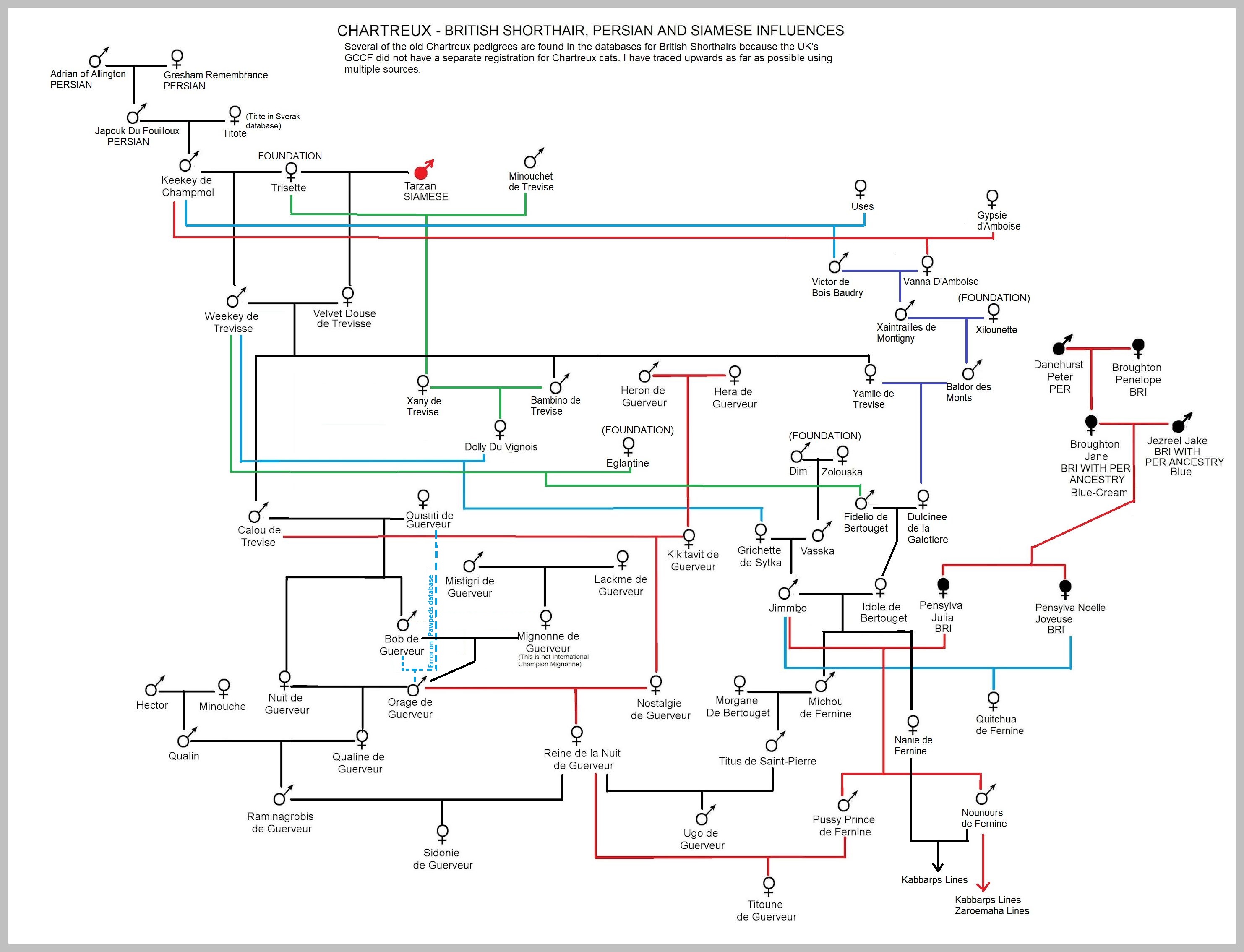
The first outcross the Leger sisters added to their breeding program was around 1953 According to Siminnet’s study of the Chartreux in 1972, in 1953, the Leger sisters bought Calou (or Calon) de Trevise from M. and Mme. Marolle. Calou was from the Cat Club stock and had Persian and Siamese ancestors, but no British Shorthair. In that same year, M. Durodie obtained Chat Comme Ca from the Leger sisters. Chat Comme Ca was bred with the Cat Club stock and a great-grandson, Guilleri d’Andeloya, was Simonnet’s first stud cat. The Legers imported another male in the early 1960s, Pussy Prince de Fernine, who was the product of a Chartreux male bred to a British Shorthair female. Around 1970, another Paris Cat Club male, Titus de St Pierre was added. In the mid to late 1970s the Leger sisters sem to have brought in a few more cats from other Chartreux breeders, including a male from Jean Simonnet, who had bought a cat from them in 1969 and who became one of their greatest supporters.
In his book “Just Cats” (1957), French cat-fancier Fernand Mery described the principal breeds of his time prefaced with these general notes: "Apart from these [Persian and Siamese] only the grey Chartreux and [the Birmanie] were known, and just barely, at that time. [. . .] In less than a quarter of a century fanciers have agreed and acknowledged officially that there are long-haired and short-haired cats. The second group, short-haired cats, comprises: Chartreux (blue-grey), Russian blues, Abyssinians, Manx cats, Burmese, Siamese, and the ever-increasing range of Europeans. In his later book, "The Life, History and Magic of the Cat" (1966) Mery wrote of the French Chartreux breed with obvious pride, stating that it was not to be confused with the British Blue, being stockier with woollier fur. "The Chartreux is a cat of rural France. [...] It has a very powerful jaw, temptingly reminiscent of that of the European wild cat. [...] Its colour can be any shade of greyish blue, though the preference is for the paler colours." A Chartreux called Weekey de Trevise who was pictured in Fernand Mery's book "The Life, History and Magic of the Cat," was even stockier than the British Blue, and he described it as having an almost comical expression.
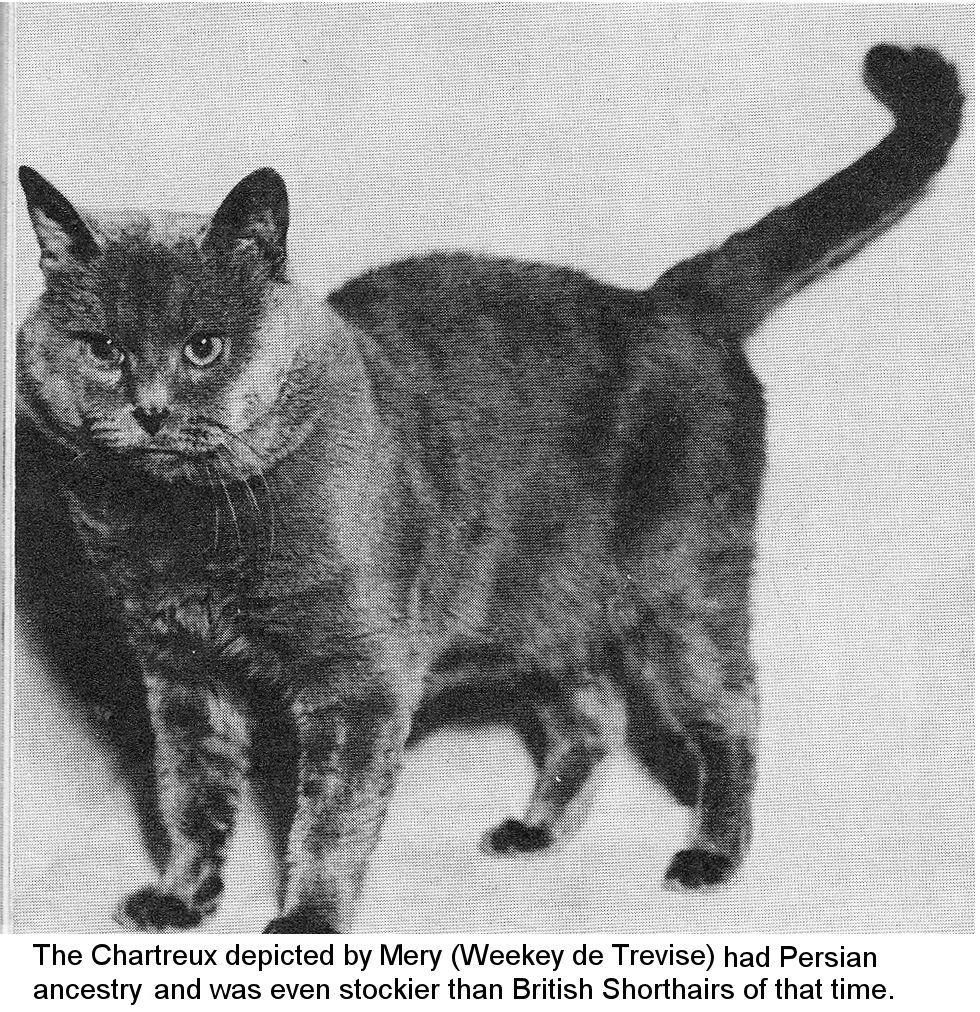
Dr. E. Dechambre (Assistant Director of the Menagerie of the National Museum of Natural History, Paris) wrote in “Cat Breeds” (from the “Encyclopédie Féline” (1957)): “The Carthusian is one of the oldest cat breeds in France. It is a short-haired, blue, orange-eyed European cat, described by Buffon in his Natural History two hundred years ago. As with most other breeds of cat, there are legends surrounding its origins. Some claim it originally came from South Africa, and was imported into France by Carthusian monks. Fitzinger claims that it originated as a cross between an Egyptian cat and a Manul. No matter what its true origin, we can say that this breed appears almost only at French cat shows. There may be similar-looking cats elsewhere, such as the British Blue, but even they differ clearly from the Carthusian in bone structure and head shape.
The Carthusian gives an impression of great strength and contrary to some authors, it is definitely not a long, slender animal like the Siamese. It has a massive body, set on long legs, and is most graceful despite its size. Its head fits into a trapezium with the longer of the two parallel sides at the bottom, whereas the head of the Siamese cat fits into a triangle stood on its point. The jaws of the Carthusian are powerful and from about two or three years old its cheeks fill out, becoming slightly jowly. It has a thick neck which merges into broad, powerful shoulders. Its chest is markedly prominent. Every feature of this breed suggests strength. The colour varies from pale grey to a deep blue-grey. The eyes are deep gold and give the face a very gentle expression.
This cat is gentle, affectionate and intelligent. It is also sturdy and easy to rear in a climate like that of the United Kingdom. It is not worried by temperature changes and its dense coat allows it to resist both cold and damp. The Carthusian is an excellent ratter. Despite its lazy appearance, it never hesitates to tackle the most powerful rodents.
Standard:
Body: A massive, heavy cat, well-muscled limbs, broad chest, dense, heavy undercoat.
Head: Broad at the bottom, with a straight nose with no stop. Medium-sized ears placed high up on a very rounded skull. Very full jowls. Eyes are yellow to orange.
Coat: Any shade of grey permissible, though the most prized colouring is a very light bluish grey. No shading or markings are allowed, and white fur loses points.
Fur: Very slightly woolly. Dense like that of the otter to the touch.
N.B. Anything suggesting a cross between the Chartreux and the Russian Blue should be disqualified.

By contrast, Dechambre combined the Russian Blue, American Blue or Maltese Cat as a single variety: “These are three names for a European short-haired, self-coloured blue cat with a slender build. It is common particularly in Britain, the Scandinavian countries and the USA. Nothing is known about its origin. The Russian Blue is sometimes confused with the Carthusian (Chartreux) cat, but the two races are quite distinct. Firstly, the eyes of the Russian Blue are green, whereas those of the Carthusian are yellow. The proportions of the two types are also different: the Russian Blue is slender, like the cats of Ancient Egypt, with fine lines and a light build which gives it a very feline appearance.”
In contrast, British cat fancier Rose Tenent ("Pedigree Cats," 1955) did not distinguish between the British Blue and Chartreux when she wrote " No cat is better known than the British Short-hair. [. . .]. In the United States the British Blue is known as the Maltese cat, and recently has enjoyed much popularity there as a household pet. On the Continent, too, this cat is becoming increasingly popular, and there its name is the Chartreuse." British breeder and judge Grace Pond simply found it confusingly similar to the British Blue!
“The Observer’s Book of Cats” by Grace Pond (1970s) mentioned the Chartreux in passing. “There are a few Blue British in Europe, but the French have a breed called the Chartreux, said to have been brought to France from South Africa by the monks of that order. They are very like British Blues, which may cause some confusion. Their standard calls for a coat of any shade of grey or greyish blue, with a head not quite so round, and with a very powerful jaw.”
Pedigree Petfoods/Peter Way Ltd; "Your Guide to Cats & Kittens" (1973): "In France, a variety similar to the British Blue has been bred and is called the Chartreux. These cats are thought to have originated from animals brought to France by the Chartreux monks of South Africa.
FIFe AND THE CHARTREUX CROSS-BREEDS
Around 1965, the Cat Club stock had become inbred. Newer breeders wanted quick results and rather than outcross to humble countryside cats they chose the British Blue Shorthair. While the first generation crosses looked promising, later generations varied in type and deviated from the Chartreux standard. Cats with very copper eyes and with a British Blue-style nose-break were, in Simonnet’s words, pseudo-Chartreux that diplayed hybrid ancestry. In 1969, Simonnet obtained the female, Sidonie de Guerveur, from Belle Ile to mate to Cat Club stock. In 1970, Titus de St. Pierre went from the Cat Club to Belle Ile and he helped improve the eye colour of the de Guerveur cats. Meanwhile, Simonnet acquired a second female, Ingrid de Guerveur, who produced lines at both Belle Ile and the Cat Club. This reinvigorated the breed in both places.
Mme Ravel, founder of FIFe (the major European cat registry), was strictly opposed to the cross-breedingis. Litters contained kittens that were closer to one or other type or intermediate between the two. In 1969 FIFe decided to unify the standards of the British and Chartreux, assimilating the Chartreux and British Blue into a single breed called "Chartreux" and adopting the breed standard of the more common British Blue Shorthair. Mr. Jean Simonnet and some other French breeders continued breeding their "pure blood Chartreux" and fought hard against The FIFe decision. Professeur Nouvel, president of the Cat Club, asked Simonnet to do research to support the identity of the Chartreux as a distinct and long-standing breed. This study was published as “Étude sur le chat des Chartreux” in 1972, and a supplement to the study in 1974.
FIFe reversed their decision in 1977, giving the Chartreux a separate breed standard, which became the basis of the modern standard. From then on, the Chartreux and British Blue Shorthair were maintained as separate breeds, and crossbreeding was discouraged. The problem was, not all European Cat Clubs were affiliated to FIFe, and they continued to use the name "Chartreux" for the British Shorthair, European Blue Shorthair or for crosses between one of these Shorthairs and the genuine French Chartreux. In German speaking countries, the term “Karthauser” (Carthusian) was officially used for the British Blue until 1991, and was misused for many years after. This was almost back to the early 1900s when all blue cats were lumped into a single “self blue” category!
The continued use of the Chartreux name for British, European and cross-bred blue shorthairs tended to occur in countries where the genuine Chartreux was rare or absent. Because the Paris Cat Club pedigrees contained Blue Persians, and because some of the British or European blues carried the recessive longhair gene, "Chartreux Longhairs" occasionally appeared. In 2002 there was a short-lived attempt by some English breeders to recognise these as “Benedictines” when they cropped up in a litter. At first FIFe looked set to recognise these variants under that name, but protests from Chartreux breeders meant this decision was reversed and longhaired variants could only be registered as "Not Recognised Longhair - XLH". "Blue-Cream Chartreux" also appeared (mainly with European breeders unaffiliated to FIFe) because Blue-Cream British Shorthairs had been used. Though no doubt attractive in their own right, breeders of the genuine Chartreux were careful not to introduce these mixed heritage cats into their breeding programmes.
Chartreux were bred on Belle Ile under the "de Guerveur" affix for more than 50 years. The most recent "de Guerveur" cat on record appears to be Pif-Paf de Guerveur, born in 1979, who was exported to North America and who appears in modern bloodlines. Modern Chartreux go back to both the Belle Ile and Paris Cat Club lines and are a combination of strength and elegance. The modern Chartreux still compares favourably to the photographs of the “de Gueveur” cats in Jean Simonnet’s book “The Chartreux Cat.” Many of the Chartreux imported into the USA in the 1970s by Helen Gamon and other early breeders are descended from the de Gueveur stock. Christine Leger died in 1986 and Suzanne in 1996. In recent years, some French breeders have carefully added new foundation Chartreux into the breed. The French registry, LOOF, has an outcross program that allows new unregistered foundation cats to be approved and added, with supervision of the resulting breeding program for four generations. Some of the new foundation cats have came from Belle Ile, which takes the breed full circle.
Monsieur Jean Simonnet published several articles about the Chartreux, a short book “Étude sur le chat des Chartreux” (1972) and the more comprehensive “Le Chat des Chartreux” (1990). The description of the English version of his 1990 book, Le Chat des Chartreux , reads “Chartreux is the French name for a short-haired, blue-grey cat which was brought from the Middle East during the Crusades. This cat was known in America at the turn of the century by the name Maltese and these cats develobed through hybridization into the contemporary breed known as the Russian Blue. Chartreux cats, however, have kept the form of their ancestors of centuries past. The author provides a detailed and fascinating history of these cats and includes many descriptions of them by the first great naturalists of the 16th-18th centuries: Aldrovandi, Buffon, Pennant, Linnaeus, etc. and descriptions by famous authors such as Colette. A chapter on the first fascinating years of the Persian Cat in Europe is also presented. For the cat fancier and breeder, the book abounds with the details & guidance on selective breeding of the Chartreux. To completely illustrate the beauty of the breed, 81 full color photogravure quality illustrations of European and American Chartreux are included along with centuries old paintings & sketches.” (This is not entirely accurate regarding the inter-relationship of the Maltese – a term mostly used for blue shorthaired North American cats – and Russian Blue.)
In Simonnet's "Etude Sur le Chat des Chartreux" there is a photograph from "Living Animals of the World" (1902) that he thought was the first photograph of a Chartreux, but which was a British Shorthair owned by Lady Alexander. "Short-haired Blue" was translated "Chat des Chartreux a poil ras." "Living Animals of the World" also contained entertaining stories about the breed that later authors (e.g. Jumaud) repeated.
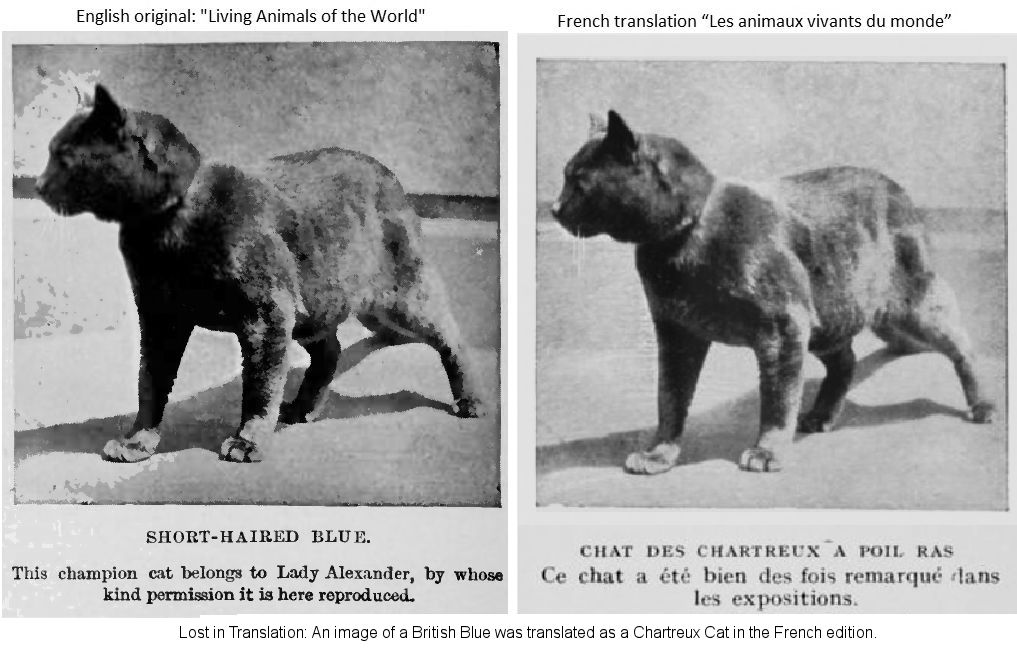
Of the Cat Club breeders, Simonnet wrote in “Le Chat des Chartreux” that they started with naturally occurring blue cats, but used the Persian cat in order to obtain cooper eyes. In 1936, that Mr. Auxion mated a a naturally occurring Chartreux female, Titote, with the Titote, with the blue Persian, Japouk du Fouillox. WWII interrupted breeding efforts and of Japouk and Titote;s offspring, only Keekey de Champmol (or Champoelle) (born 1936) survived the war. Mr. and Mrs. Marolle, bred their grey-blue female, Trisette, to Keekey, resulting in Weekey de Trevise (born 1948). Weekey appears in the pedigree of most of the Cat Club stock. Around 1960, the cat Club succeeded in removing the Persian influence while retaining the copper eye colour. In 1960, Jimmbo was born and had the essential characteristics of the Chartreux we see today.
CHARTREUX IN THE USA
The first Chartreux were taken to the USA in 1971 by Helen and John Gamon of La Jolla, California. These were from Paris Cat Club bloodlines. Ixion de Guerveur was imported in 1973, Jasmine de Guerveur was imported in 1974. Further Chartreux imports had "de Guerveur" lines behind them. CFA insisted that they could only register them as Exotic Shorthairs, since there was a Persian outcross in the pedigrees that had been done in 1936. This was not acceptable to the Chartreux breeders, so it took a long time to get the breed accepted in CFA (finally accepted in 1987). The breed now has championship status in all major US cat associations in the US (CFA (1987), TICA (1979), ACFA, and CFF). After remaining relatively rare for many years its popularity has soared, especially in its native land.
The US standards called for relatively fine leg boning, a feature seen in the original cats imported in the early 1970s. Compared to British Shorthairs, the Chartreux lacked thick heavy boning in the legs with large feet. hose early 1970s Chartreux had muscular bodies, though less cobby in type than British Shorthair, but the lack of heavy boning in the legs made their feet look comparatively small. In order to gain recognition, the Chartreux needed to be distinct from the British Blue Shorthair so Chartreux breeders emphasised their breed's contrast between body mass and leg boning, the relatively small tapered muzzle, and the high set ears.
European standards call for more sturdy legs and larger feet. In the 1990s, at the National Cat Club at Olympia, a British judge offhandedly told me the Chartreux wasn't recognised because it was the same thing as the British Blue and there was no point having two names for the same type of cat! The original Chartreux on Belle Ile were more elegant in body type than the modern Chartreux, similar to the Russian Blue.
Unlike many breeds with a long history, the Chartreux has remained almost unchanged in looks since the 1930s. Some of the purest Chartreux bloodlines are now to be found in the USA where it was maintained separately from the British and European Blue Shorthairs.
Traditionally, the first letter of the official name of a Chartreux cat relates to its birth year so that all Chartreux kittens born in the same year have official names beginning with the same letter. The letters follow the alphabet, omitting K, Q, W, X, Y, and Z as it’s hard to find enough names beginning with those letters.